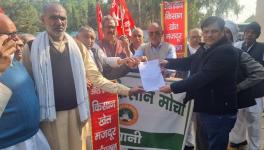Farmers Continue to Innovate With Their Protests
Holding of Kisan Sansad has now brought the farmers’ agitation to the vicinity of Parliament. While the government has been trying to break the protest, the Kisan Sansad heralds a new beginning, writes ARUN SRIVASTAVA.
WORLD history is full of narratives of peasant struggles and uprising. India also has seen many of them which had different perspectives and dimensions.
Early peasant movements were usually against feudal and semi-feudal societies and resulted in violent uprisings.
However, recent movements are much less violent, and their demands are centred on better prices for agricultural produce, better wages and working conditions for the agricultural labourers, and increasing agricultural production. The economic policies of the British adversely affected Indian peasants. The peasants in Bengal formed their union and revolted against the compulsion of cultivating indigo. The Indigo Rebellion is an important part of the peasant’s struggle in Bengal. Later under the leadership of the CPI, peasants in Bengal launched the tebhaga movement in the 1940s.
The Kisan Sabha movement started in Bihar under the leadership of Swami Sahajanand Saraswati, who formed the Bihar Provincial Kisan Sabha (BPKS) in 1929 to mobilise peasant grievances against the zamindari attacks on their occupancy rights.
In 1938, crops in Eastern Khandesh were destroyed by heavy rains. The peasants were ruined. In order to get the land revenue waived, Sane Guruji organised meetings and processions in many places and took out marches to the Collector’s office. The peasants joined the revolutionary movement of 1942 in great numbers. It was a sort of political intervention.
We ought to realise the difference between the earlier peasant struggles and the current farmers’ movement. Farmers can effectively make political interventions, but it would be really tough for them to float their own political party to participate in the electoral process.
The farmers’ satyagrah that has been going on in India is unique in terms of its political nature. It has sustained due to its uniqueness.
A look at the 40 odd farmers’ unions that constitute the Samyukt Kisan Morcha (SKM), spearheading the agitation would make it explicit that they nurse their own political ideologies and affiliations, but for the greater cause they have kept their political ideologies on the back burner. This is why the agitation has succeeded in staying alive and also why the government has failed to break their unity to end the agitation.
Participants at the sansad revealed that the mandi system crumbling as it was under duress. They narrated how a lot has changed since they first started protesting at Delhi’s borders in late November last year. A farmer from Haryana said mandis had stopped functioning in the state’s four districts.
Many also raised questions about the minimum support price (MSP) and how many farmers actually receive it. One of them said, “Mandi system has its flaws but we were asking them to fix it. Instead, they’ve finished around 80 mandisin the state. It is eventually becoming completely privatised. The government did not purchase moong and makki from farmers this year but procured it privately. By discouraging us to grow certain crops, they are indirectly encouraging private players. This is what happened with soya bean oil, which is now only produced privately and costs around Rs 250 per litre. Earlier, it was lower than Rs 100. If no one else grows it, private players hoard it and the price keeps increasing.”
He added that farmers and labourers struggled during the second wave of Covid as they did not receive their dues, nor could they approach courts.
All India Kisan Sabha general secretary Hannan Mollah rightly pointed out; “We are showing them how to conduct a Parliament with knowledgeable discussions. The government says the farmers are uneducated, they say they need to educate the farmers about the impact of these three farm laws. Listen to the debates here. Is it not clear that the farmers have understood how their lives and livelihoods will be hurt by these laws?”
This will also make the common farmers conscious of the spirit and dynamics of their movement. Speakers have been laying out their charges against the three laws, that they were unconstitutional, that they were enacted using undemocratic practices, and that they will devastate the rural economy.
The gains of the initiative could be made out from the speech of Jasbir Kaur, committee member of Punjab Kisan Union, at the Sansad: “These laws will lead to the end of the existing mandi system and MSP procurement. It will result in farmers, agricultural labourers and mandi workers being deprived of their jobs. And when the private mandis come, replacing the government mandis, their infrastructure will only benefit Ambani and Adani, not farmers,”
Raminder Singh Patiala, a leader of the Kirti Kisan Union, said, “If the fields and crops of this country go into the hands of corporates, if they take control of our harvests and our grain, then it is the people who will go hungry and face starvation. That is why this is the protest not just of farmers, but of the people. This is a Jan Sansad.”
Half of the protestors were from Punjab, where the agitation has been strongest, with the other half hailing from other States.
“These laws are actually dead already, but we still need the government to issue the death certificate,” said Swaraj India president Yogendra Yadav. He warned Opposition MPs, who have been issued a “voters whip” by the farmers that if they fail to take up the issue continuously in Parliament, they will face the same farmers’ boycott as BJP MPs.
It was quite significant that while the Parliament session was ongoing, more than 20 MPs from Kerala arrived at the Kisan Sansad to express their solidarity. But they were not allowed to speak at the Kisan Sansad. This is in fact the strength of the movement.
The farmers’ movement has been consistently striving to protect the democratic institutions from being subverted and reinvigorate the political system. Farmer leaders going around the country must not be construed as their weakness. This was their fraternal gesture for conjuring the voters and common people not to support the BJP which has been jeopardising their economic interest.
Rakesh Tikait, who heads a large faction of the Bharatiya Kisan Union in western Uttar Pradesh correctly holds that the arrival of farmers at Jantar Mantar was a sign of progress. “The distance between us and the parliament is constantly reducing, we are just a few hundred metres away now,” he said.
The Kisan Sansad has attained importance for one important reason. This has provided the much-needed opportunity for the women representatives to express their views and it was encouraging to notice that they were more incisive and focused than the male leaders.
It is worth noting that forty-five speakers spoke on the Farmers’ Produce Trade and Commerce (Promotion and Facilitation) Act, 2020. This is for the first time in the history of Independent India that a parliament of farmers was in session simultaneously with the Indian Parliament. Already, farmers from 20 states have reached the agitation site and as Swaraj India chief Yogendra Yadav informed that farmers from more states would come to the capital to take part in the Sansad.
Benoy Thomas of Vellad village in Kerala’s Kannur district said, “I am a lawyer, but I cultivate two acres in my village. According to the Essential Monsoon Session Barricades Commodities (Amendment) Act, any person can now store agricultural produce without limit. This will lead to hoarding and during wars or pandemics, the government may not be able to provide food grain to the poor.” (IPA Service)
The article was originally published in The Leaflet.
Get the latest reports & analysis with people's perspective on Protests, movements & deep analytical videos, discussions of the current affairs in your Telegram app. Subscribe to NewsClick's Telegram channel & get Real-Time updates on stories, as they get published on our website.
























